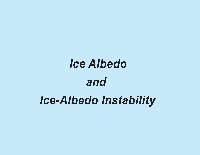 | Here
are teaching slides for "Ice albedo and ice-albedo instability".
You can see a full-size version by clicking on the thumbnail. You can then
download that slide individually by right mouse clicking on it; using the "Save
As" command in the File menu; or in most cases, by simply dragging it to
your desktop.
|
|
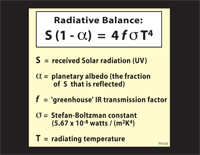 | 7.2:
The radiative balance equation: Earth’s radiating surface temperature
self-adjusts to balance incoming Solar (short-wavelength) radiation with
outgoing (long-wavelength) radiation.
|
|
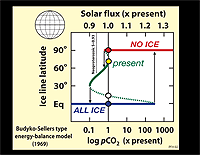 | 7.3:
Ice-line latitude on an all-ocean planet as a function of Solar flux or
equivalent
pCO2, based on a simple energy-balance model of the
Budyko-Sellers type. Under the present Solar flux (1.0), three stable climate
states are possible,
all ice (blue), no ice (red) and small ice (yellow). Large ice (open circle)
is unstable and spontaneously falls to all ice. Black arrows indicate jumps
in the CO2 hysteresis loop of a snowball earth cycle.
|
|
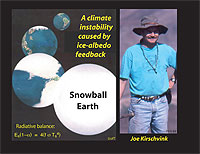 | 7.4:
Joseph L. Kirschvink, originator of the snowball earth concept, a self-reversing
climate instability driven by ice-albedo feedback.
|
|
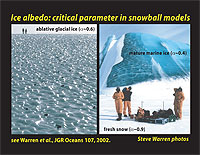 | 7.5:
Ice albedo is a critical variable in snowball earth climate models: snow-covered
ice has a high albedo (~0.9), bubble-free (mature) marine ice has relatively
low albedo (~0.4) and bubble-rich glacial ice (compacted snow) has intermediate
albedo (~0.65).
|
|
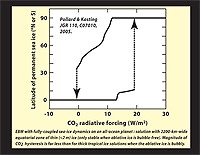 | 7.6:
Ice-line latitude on an all-ocean planet as a function of CO2 radiative
forcing in an energy-balance model with fully-coupled sea-ice dynamics
(Pollard & Kasting,
2005). Solution shown assumes bubble-free ice in the ablative zone, where
thin ice (<2 m thick) occupies a ~2200-km-wide equatorial band, permitting “healthy” rates
of photosynthesis to occur. If the ablative ice is bubble-rich, equatorial
ice is thick and the CO2 hysteresis is magnified.
|
|
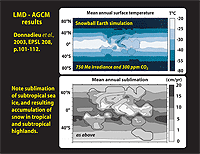 | 7.7:
Atmospheric general circulation model (AGCM) with reduced solar luminosity
and paleogeography
appropriate for 750 Ma, in which a snowball earth (equatorial surface temperature <0ÅC)
occurs with CO2 set to (pre-industrial) 300 ppm (Donnadieu et al., 2003).
Net sublimation is widespread on sea ice, most strongly in the subtropics,
implying significant snowfall on land-based (elevated) tropical ice sheets.
|
|
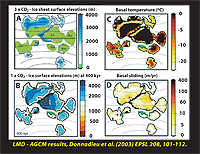 | 7.8:
Simulations using an AGCM for 750 Ma with coupled sea-ice and ice-sheet
dynamics (Donnadieu et al., 2003): (A) with 900 ppm CO2, land-based ice
sheets build up but the ocean remains open; (B) with 300 ppm CO2, ocean
is completely ice covered but land-based ice sheets continue to grow, covering
most global land area by 400 kyr after snowball onset; (C) same as (B)
showing basal temperature of land-based ice sheets; (D) same as (B) showing
basal sliding velocities of land-based ice sheets. Note the narrow corridors
of fast-flowing wet-base ice (ice streams) near the margins of the tropical
ice sheets.
|
|
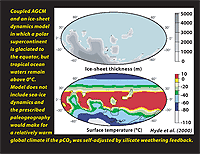 | 7.9:
Simulation using an AGCM with coupled ice-sheet dynamics (no sea-ice dynamics)
and a ca 575 Ma paleogeography in which a loose supercontinent stretches
from pole to equator (Hyde et al., 2000). Within a prescribed range of
CO2, equatorial margins of the supercontinent are glaciated, as a result
of ice-sheet flowage, while the tropical ocean remains above the freezing
point.
|









